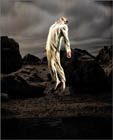|
|
| home > coffee break > it revolution |
|
IT REVOLUTION |
||||
| Fear of the Demo? Antonino Saggio |
||||
 Maia Engeli "Digital Stories. The Poetics of Communication" (The IT Revolution in Architecture) Switzerland 2001 Birkhäuser pp96, $12,50 preface by Antonino Saggio buy the book online and save! |
||||
| [in italiano] > IT REVOLUTION BOOK SERIES |
The old idea of the computer was
linked to incommunicability. People who knew how to use it were cloaked in an aura of technical mystique. They tapped out abstruse codes
and, as if by miracle, figures, tables, equations and graphs appeared. They wore white coats and, preferably, thick glasses. Above all,
they spoke almost no ordinary language, so the others just had to lie back and wait for the results. But, nowadays, the others have become
players. The revolution came in three stages, all three generated from below. The first was linked to the birth of the personal computer. In the mid seventhies, the "techno" arm of the period's counterculture showed that instead of being the exclusive prerogative of elite groups (military, financial, academic and professional), the power of computing could be extended to the masses. Personal computers sprang up from garages, lofts and kitchens turned into workshops, to gradually conquer the mass market. And even the giants were forced to produce an object they had scorned for years. The second revolution was centred on the struggle between uncommunicability / communicability. The first personal computers were based on an industrial, mechanical language. It was assertive and certain. You had to write exactly what you wanted to do. An error in punctuation, a comma instead of a full stop, blocked communication between user and machine. The language that spread from 1984 was instead metaphorical. Communication was solved through "images". Of course, in the information era, the possibility of condensing dozens and dozens of bits of data in significant blocks - images, in fact - is the key. We have already talked about the fact that the rhetorical figure has once again taken center place because the problem has been officially posed of communicating rapidly in an inter-connected, directed, anti-objective and anti-assertive fashion. The third step was based on the creation of a new modular programming language (i.e. that can function by independent parts), multi-platform (that can control different computer types and models), multimedia (that can use digital data that describe different outcomes: sounds, film, three-dimensional objects, texts etc.) and, last but not least, easy to learn and manage. The first large-scale launch was Hypertalk, while the language most widely used today is HTML (Hyper Text Markup Language), which, as is well known, was the basis of the worldwide Internet revolution. William Atkinson and Hypercard in the first case, Mark Andreesen and Netscape in the second, were the drivers of a wave of change that has affected millions of people. And now to come to this book. What is the fundamental question being asked here? We could say that Digital Stories, The Poetics of Communication starts out from an assumption. Communication is one of the centers of the information era because it is a "structural" component of today's society. Given that information is the primary commodity, the capacity for transmission, we could say "distribution", is the necessary consequence. Today more than ever, without communication you could do almost literally nothing. The desire to know, to understand, to be able to participate in decisions is more and more widespread. The information society, even if it also hides worrying Orwellian scenarios, can lead to clearer and more extensive participation. The process towards communication is in any case an unstoppable trend. The problem for everyone is, once again, "how". Communication demands, for architects in general and especially for the increasing ranks of specialists who deal with the "communication project", an increasing degree of awareness. It is on this search for awareness that the author works. She highlights, first of all, the structure of the data, the medium of the screen, the method of language by images, and sequential and hypertext sequences. The thesis underlying the various materials is that communication also opens up a new "narrative" space, in tune with a general interest for architecture that re-discovers multiple layers of meaning. Architecture itself appears less and less as an objective fact, as a functionalistic and mechanistic Sachlichkeit, and becomes more and more what it is, a fact of communication. Maia Engeli can interweave this communicative component within the architecture-computer relationship for many reasons. The first, not insignificant one, is a personality open to the communicative and literary dimension that broadens strictly technical knowledge. In addition, having frequented Nicholas Negroponte's Media Lab, and the contact with an inspirer of messages like Muriel Cooper, together with experimentation conducted both alone and with her students in Zurich, certainly make her a point of reference. Indeed, the book itself is an example of communication, even just leafing through it, reading the captions, flipping through the bottom of the pages with images that make up a film. Underlying this effort is the great lesson of pragmatism. Ideas must be put into practice, be experimented, become things. John Dewey indicated "learning by doing", "demo or die" is Negroponte's formula. A formula which, from the kids who invented the first personal computers in the seventies to this book, travels like a challenge towards more abstract, theoretical, cerebral cultures. In brief, experimentation, even and above all in communication is a must. "Don't Fear the Demo" is the encouragement we need. Antonino Saggio |
[05nov2002] | ||
|
coffee
break | forum | scrivi all'autore |
||||
|
Per qualsiasi comunicazione laboratorio
|